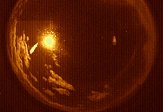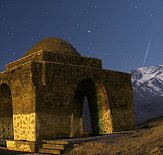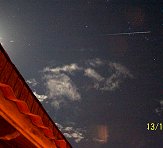| |
| |
Photographer,
Location |
Images |
Comments |
|

[listen]
|
Thomas Ashcraft, New
Mexico, USA
Dec. 14, 2008
|
#1,
more |
Editor's
note: Amateur radio astronomer Thomas Ashcraft operates
a dual radio-optical meteor monitoring system. An all-sky
video camera records fireballs as they streak overhead,
while an antenna array records the reflections of distant
radio stations from the meteor's ionized trail. The eerie-sounding
echoes are wonderful!
Ashcraft's
comments: "In the midst of moonlight and fast moving
clouds, I am pleased to report a strong showing of Geminid
fireballs. Forward scatter reception was saturated with
accumulated asteroid dust but still the fireballs rang through."
|
|

|
Babak
Tafreshi,
Kashan, Iran
Dec. 14, 2008 |
#1,
#2,
#3,
#4,
more |
For
the 2008 Geminid meteor shower I was under crystal clear
sky in central Iran, at the ancient fire temple of Zorostrian
era in Niasar, near Kashan. The show was not much spectacular
because of the bright moon but still there was quite a number
of beautiful bright meteors. |
|

[movie]
|
Dr. Bill Cooke, Marshall Space
Flight Center, Huntsville, Alabama
Dec. 14, 2008 |
#1,
movie,
more |
"Wow!
This was one of the best displays of Geminids we've ever
seen," says Bill Cooke of the Marshall Space Flight
Center in Alabama. NASA's Asgard-Sentinal
meteor camera recorded more than 80 bright Geminids during
the long night of Dec. 13-14 in spite of bright moonlight
and many clouds. In the
movie, note the circular halo that forms around the
Moon as it arcs across the sky; that is caused by ice crystals
in high clouds.
|
|


|
Rob
Stammes,
In my instrument room in the polarlightcenter, Laukvik, Lofoten,
Norway.
Dec. 14, 2008 |
#1,
#2,
more |
I
am counting meteors with my old, always working, analog
system. Last night detecting the Geminids with my meteor
radio reflecting system I counted about 118 meteors per
hour around the maximum.On a meteor quiet night I detect
normally at the same time about 24 meteors per hour. That
means 94 Geminids last night around 02.30 UTC. System: VHF56.25
MHZ, audio signal TV transmitter Litouwen. Antenne direction
around zenith. |
|

|
Frankie
Lucena,
Cabo Rojo,Puerto Rico
Dec. 13, 2008 |
#1 |
By
shielding the moons glare with the roof of the house ,I
was able to photograph this Geminid gliding thru Orion's
belt. Photo
Photo
details: Kodak Z740 at F/2.8 for 8 secs at 400asa.
|
more
images: from
Xiang Zhan of Jietaisi, Beijing, China; from
J.D.Strikis of Athens Greece; from
Aymen Ibrahem of Bahariya Oasis, Egypt;
|
|